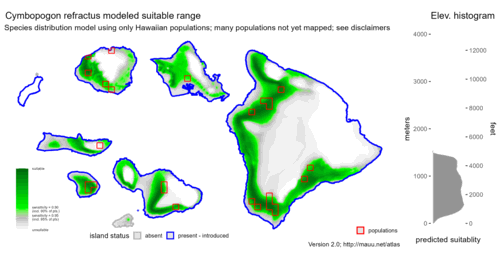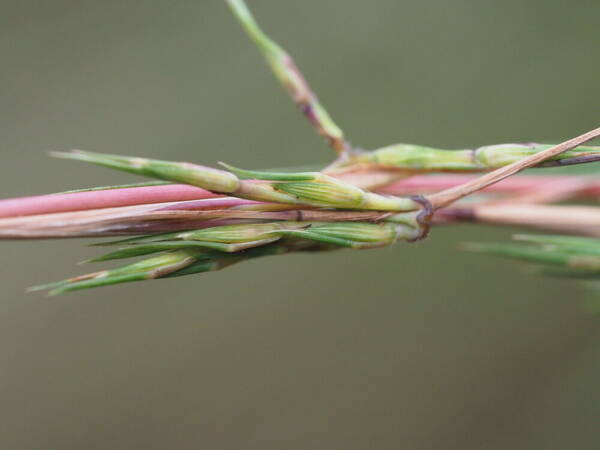Info
Subfamily: Panicoideae
Genus etymology: Cymbopogon = "boat beard" [Greek] refering to the boat shaped spathes located below the hairy florets
Species etymology: refractus = "bent backwards" [Latin] refering to the reflexed inflorescence branches
Photosynthetic type: C4 (warm season)
Nativity: naturalized - accidental
First recorded in Hawaiʻi: 1929
Legal status: HDOA - noxious weed
Map


Inflorescence


Plant

Habit

Spikelets












Landscape

Description
Habit: Perennial; caespitose. Culms erect; 50-100 cm long; 2-3 -noded. Culm-nodes glabrous. Ligule an eciliate membrane; 2 mm long. Leaf-blades flat, or revolute; 10-25 cm long; 1.25-2 mm wide; aromatic. Leaf-blade surface scabrous; rough abaxially. Leaf-blade margins scabrous. Leaf-blade apex attenuate. Inflorescences: Synflorescence compound; linear; lax. Inflorescence composed of racemes; terminal and axillary; subtended by a spatheole; enclosed. Spatheole 2-2.5 cm long. Peduncle 0.5-1 cm long. Racemes 2; paired; deflexed; 1-2 cm long; bearing 2-6 fertile spikelets on each. Rhachis fragile at the nodes; semiterete; ciliate on margins. Rhachis hairs 1.75 mm long. Rhachis internodes linear; 3 mm long. Rhachis internode tip transverse; cupuliform. Raceme-bases flattened; subequal; 1-5 mm long. Spikelets in pairs. Fertile spikelets sessile; 1 in the cluster. Companion sterile spikelets pedicelled; 1 in the cluster. Pedicels linear; semiterete; 3 mm long; ciliate; with 1.75 mm long hairs. Sterile Florets: Basal sterile spikelets represented by a single scale; 2 in number (lower raceme); 0 in upper raceme; sessile and pedicelled. Basal sterile spikelet pedicels free; linear. Basal sterile spikelets equalling fertile. Companion sterile spikelets well-developed; comprising 2 unequal glumes without lemmas; lanceolate; 5 mm long; as long as fertile; deciduous with the fertile. Companion sterile spikelet glumes coriaceous; 11 -veined; acuminate; pungent. Spikelets: Spikelets comprising 1 basal sterile florets; 1 fertile florets; without rhachilla extension. Spikelets lanceolate; dorsally compressed; acuminate; 4.5-6 mm long; falling entire; deciduous with accessory branch structures. Spikelet callus pilose; base obtuse; inserted. Basal sterile spikelets represented by a single scale; 2 in number (lower raceme); 0 in upper raceme; sessile and pedicelled. Basal sterile spikelet pedicels free; linear. Basal sterile spikelets equalling fertile. Companion sterile spikelets well-developed; comprising 2 unequal glumes without lemmas; lanceolate; 5 mm long; as long as fertile; deciduous with the fertile. Companion sterile spikelet glumes coriaceous; 11 -veined; acuminate; pungent. Fertile Spikelets: Spikelets comprising 1 basal sterile florets; 1 fertile florets; without rhachilla extension. Spikelets lanceolate; dorsally compressed; acuminate; 4.5-6 mm long; falling entire; deciduous with accessory branch structures. Spikelet callus pilose; base obtuse; inserted. Glumes: Glumes dissimilar; exceeding apex of florets; firmer than fertile lemma. Lower glume lanceolate; 1 length of spikelet; chartaceous; 2-keeled; keeled laterally; wingless. Lower glume intercarinal veins distinct; 4-5 in number. Lower glume surface flat. Upper glume lanceolate; chartaceous; 1-keeled; 7 -veined. Upper glume margins ciliolate. Upper glume apex acute, or acuminate. Florets: Basal sterile florets barren; without significant palea. Lemma of lower sterile floret lanceolate; 4.5 mm long; hyaline; 1 -veined; without lateral veins; ciliolate on margins. Fertile lemma lanceolate; 3.5 mm long; hyaline; without keel. Lemma margins ciliolate. Lemma apex entire, or dentate; 2 -fid; mucronate, or awned; 1 -awned. Principal lemma awn from a sinus; straight; 1-12 mm long overall; without a column. Palea absent or minute. Flowers: Anthers 3. Fruits: Caryopsis with adherent pericarp; ellipsoid; 2.5 mm long. Distribution: Australasia: Australia. Pacific: southwestern, south-central, northwestern, and north-central.
(Description source: Clayton, W.D., Vorontsova, M.S., Harman, K.T. and Williamson, H. (2006 onwards). GrassBase - The Online World Grass Flora. Available at https://powo.science.kew.org )
Densely tufted perennials; culms 25-75 cm tall, nodes purple, glabrous. Sheaths 2- 7 mm long, glabrous to sparsely pubescent, striate, the basal ones purple to pink, more or less persistent; ligule 1-2 mm long, membranous, erose; blades narrowly linear, 15- 25 cm long, ca. 1.5 mm wide, wiry, scabrous. Inflorescences 10-30 cm long, narrow, the branches erect, racemes well spaced, each pair partly enclosed in a slightly inflated pink or bronze spathe 2-3 mm long, racemes 2-3 cm long, slender, reflexed, rachis joints and pedicels flattened, hispid on the angles; sessile spikelets narrowly lanceolate, 4.5-5.5 mm long, acuminate, callus short-bearded, first glume strongly 2-keeled, 9-nerved, acuminate, glabrous, second glume slightly shorter, 1-keeled, 7-nerved, acute to acuminate, sterile lemma hyaline, 4-4.5 mm long, acuminate, fertile lemma 3.5-4 mm long, keeled toward apex, acute and awnless, palea absent; pedicellate spikelet sterile, 3.5-5 mm long, attenuate, glabrous, first glume usually 11-nerved, second glume 2/3 as long as first glume, 3-nerved, acute, lemma absent. Caryopsis narrowly ellipsoid, ca. 2.5 mm long.
(Description source: O’Connor, P.J. 1990. Poaceae, pp. 1481–1604. In: Wagner W.L., Herbst D.R. & Sohmer S.H. (eds.)., Manual of the flowering plant of Hawaiʻi. Vol. 2. University of Hawaii Press & Bishop Museum Press, Honolulu )